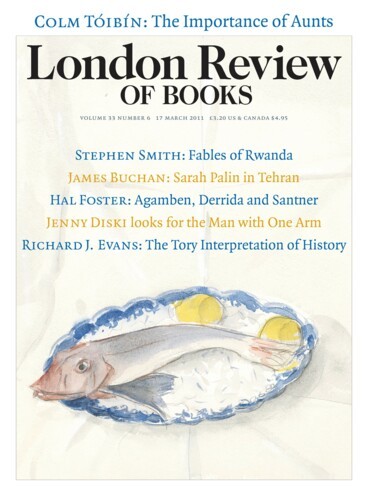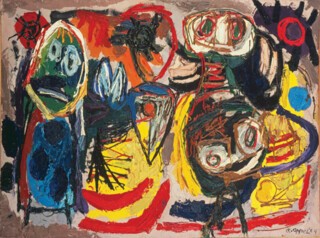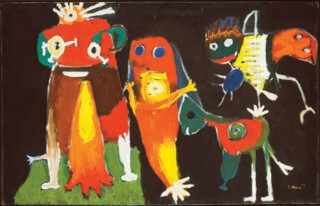Over the last decade or so critical theory has seen a marked turn to questions of ‘bare’ and ‘creaturely’ life. Why this interest in such threshold states? What’s at stake here? This kind of discourse, in which the ideas of Giorgio Agamben, Jacques Derrida and Eric Santner are central, has little to do with animal rights, and whatever bestiality is at issue is entirely our own. (As Derrida points out, animals are not cruel to one another; only ‘man is wolf to man,’ as the ancient saying, revived by Hobbes, has it: homo homini lupus.) For that matter, the connection between this discourse and human rights isn’t always clear either. Rather, it is concerned above all with the nature of sovereignty and the origin of law, or, more exactly, with what appears to be the lack of any solid basis for these institutions, at least one that is not founded in violence, the violence of self-authorised power. It is this paradox that intrigues these theorists: that the beginnings of sovereignty and law seem to lie in an exception to the just rule that they otherwise purport to represent and to secure. They puzzle over this conundrum for what it might tell us not only about power as such but also, implicitly, about wayward governments and rogue states in our own time.
Before his death in 2004, Derrida devoted his last seminar at the Ecole des hautes études en sciences sociales to a set of reflections on ‘the beast’ and ‘the sovereign’; these 13 sessions are now translated into English essentially as they were given then. Again and again, as Derrida begins a seminar, he juxtaposes the two words, at once bringing them together and holding them apart through the gendered distinction between la bête and le souverain. Yet it isn’t the difference between female and male that concerns him here; that binary, which Freud, Lacan and feminist theorists made crucial to our understanding of other differences, is displaced by another, between the human and the animal. At first glance this seems a traditional move, a return to an old line in philosophy that defines the human in noble contradistinction to the animal: man as the animal with reason, with language, with history and so on. In this discourse on the creaturely, however, the animal is less alien to the human than intimate with it. What interests Derrida is that, even as the beast and the sovereign are antipodal – the one lowly, the other supreme, the one beneath the law, the other above it – they are also alike in this exceptional exteriority, and have often been represented as such, in the guise of each other: the prince as wolf, the beast as king, with the most celebrated instance being Hobbes’s Leviathan. In this ‘obscure and fascinating complicity’, this ‘worrying mutual attraction’, Derrida searches for a key to the greater mystery of the foundation of law – or, again, the absence of such foundation.
Here Derrida is close to Agamben, whose reflections on ‘sovereign power and bare life’ were first published in Homo Sacer in 1995, and he knows it.* Yet rather than acknowledge this precedence, Derrida contests Agamben, and these ungracious moments mar his otherwise generous meditations. (Ironically, for a theorist famous for his suspicion of origins, Derrida works to out-genealogise and out-philologise Agamben, which is a difficult thing to do.) Agamben’s subject is ‘bare life, that is, the life of homo sacer (sacred man), who may be killed and yet not sacrificed’. This man is sacred in the antithetical sense of the word now all but lost to us, that is to say, accursed, at the mercy of all. Indeed, in the Roman social order homo sacer was the lowest of the low, yet as such he was also the complement of the highest of the high:
At the two extreme limits of the order, the sovereign and homo sacer present two symmetrical figures that have the same structure and are correlative: the sovereign is the one with respect to whom all men are potentially homines sacri, and homo sacer is the one with respect to whom all men act as sovereigns.
Essentially, then, what the doubling of beast and sovereign is in Derrida, the doubling of homo sacer and sovereign is in Agamben – a riddle that indicates how power is founded in a primordial yoking of violence and law. For it is the original exclusion of homo sacer, Agamben contends, that authorises the sovereign and ‘founds the city of men’; this act forges ‘the originary “political” relation’. Just as Derrida dwells on the saying of Plautus, homo homini lupus, Agamben dwells on a fragment of Pindar: ‘The nomos, sovereign of all,/Of mortals and immortals,/Leads with the strongest hand,/Justifying the most violent.’ It is this ‘knot’ – the supreme ruler as ‘the point of indistinction between violence and law, the threshold on which violence passes over into law and law passes over into violence’ – that he teases out.
The key modern precedent in this discourse on power is Carl Schmitt, who is recovered for his notion of ‘the enemy’ as a way for any state to manipulate its subjects; for his theory of ‘decisionism’ whereby a political action is validated not on its own merits but by the authority of the ruler (‘I am the decider,’ as Bush liked to say); and, above all, for his concept of the ‘state of exception’ to the law that founds the law. In Schmitt the state of exception is not a primordial event lost in the mists of time; it recurs whenever a government declares a ‘state of emergency’ and suspends its own judicial code. In fact, as foreseen by Walter Benjamin in ‘Theses on the Philosophy of History’ (1940), his final text before he committed suicide while in flight from Nazi Europe, this state threatens to be ‘not the exception but the rule’. Agamben effectively turns this foreboding into a principle: ‘The Jews were exterminated not in a mad and giant holocaust,’ he writes, ‘but exactly as Hitler announced, “as lice”, which is to say, as bare life. The dimension in which the extermination took place is neither religion nor law, but biopolitics.’ Agamben then extends this principle to a judgment on postwar modernity at large: bare life now approaches normative status, he argues, and the camp is the ‘new biopolitical nomos of the planet’. Agamben derives his notion of biopolitics, or the administration of human life as so much vital matter, from Foucault, and it becomes his version of the famous Hegelian thesis, proposed by Alexandre Kojève in the 1930s, that ‘the end of history’ has come – the end of man in any humanist sense. ‘The only task that still seems to retain some seriousness is the assumption of the burden – and the “total management” – of biological life, that is, of the very animality of man,’ Agamben writes in The Open (2002). ‘Genome, global economy and humanitarian ideology are the three united faces of this process in which posthistorical humanity seems to take on its own physiology as its last, impolitical mandate.’
Powerful though it is, this account of an utter administration of life is too total; at the very least, the designation of homo sacer differs across time and culture. If the verminous Jew was a ‘flagrant case’ in Nazi Germany, the terroristic Muslim is often so targeted in the contemporary West; the hooded victim in the infamous photograph from Abu Ghraib can be taken as a recent figure of homo sacer, one ‘who may be killed and yet not sacrificed’ (already in the concentration camps witnessed by Primo Levi, the lowest of the low were called ‘Muselmann’). It is important to complicate, even to historicise, this picture of bare life, for otherwise it becomes not only too total in political terms but also too given in ontological terms.
On this score, Eric Santner’s On Creaturely Life is helpful.† ‘Creaturely life’, as Santner defines it – ‘life abandoned to the state of exception/emergency, that paradoxical domain in which law has been suspended in the name of preserving law’ – is close to bare life. But he adds two important touchstones of his own, Kafka and W.G. Sebald, some of whose characters, caught between human and nonhuman states, or stranded in the vertiginous space of exile, allow Santner to imagine bare life from the position of homo sacer, on ‘the threshold where life takes on its specific biopolitical intensity, where it assumes the cringed posture of the creature’. For Santner what produces this cringe is ‘exposure to a traumatic dimension of political power’, where life becomes a matter of politics and politics penetrates the matter of life. This exposure is obscene, to be sure, yet it can also reveal faults not only in the social order but also in the symbolic order – ‘fissures or caesuras in the space of meaning’, as Santner puts it – which might in turn become places where power can be resisted or at least reimagined.
‘What I am calling creaturely life,’ Santner writes, ‘is the life that is, so to speak, called into being, ex-cited, by exposure to the peculiar “creativity” associated with this threshold of law and non-law.’ This creativity can take the form of criticality. Certainly this was the case for the philosophers evoked in all these texts, who witnessed the workings of power during times of crisis, or indeed, states of emergency: Hobbes laboured on Leviathan during the Civil War (it appeared in 1651, the year the war concluded); Rousseau conceived The Social Contract as the authority of European kings and princes began to crumble (it was published in 1762); Benjamin wrote his ‘Critique of Violence’ in 1921, in the wake of a destroyed Reich and in the midst of the Freikorps’ rampages; Bataille debated the nature of sovereignty with his friends in the Collège de Sociologie as Fascism spread through Europe; and Schmitt devised his juridical theories as the Nazis gathered in force and rose to power. It is also no accident that in his first seminar on ‘the beast and the sovereign’, on 12 December 2001, Derrida speaks of the double figure of terrorism, state as well as non-state.
Yet it is hardly 9/11 alone that produced the present conditions of radical insecurity. The last decade has included a stolen presidential election, the deception of the Iraq War and the debacle of the occupation, Abu Ghraib, Guantánamo Bay, rendition to torture camps, another problematic presidential election, federal indifference to the victims of Hurricane Katrina, the scapegoating of immigrants, the ecological disaster, the financial house of cards, the weird attack on government by those who would take it over (the Tea Party), the equally weird attack on society in the name of ‘Big Society’ and so on. For all the discussion of ‘failed states’ elsewhere, our own have come to operate routinely as ‘rogues’ (a rogue, Derrida reminds us, is one ‘who does not even respect the law of the animal community, of the pack, the horde, of its kind’). Clearly, in this capacity, they threaten us too, and not only with the utter deregulation of the neoliberal utopia. Schmitt once summed up Hobbes thus: ‘Protego ergo obligo is the cogito ergo sum of the state.’ ‘I protect, therefore I obligate’: that could be the legend on the Homeland Security seal.
The historical conditions for this extended discourse on sovereign power thus seem clear enough. But what are its implications? I will point to two, one specific, the other general, among many others that might be proposed. The first concerns my own field, modernist art, in particular its persistent fascination with the art of the child, the insane and the primitive. For the most part the inquiry has been conducted in terms of the unconscious and the other, that is, in the languages of psychoanalysis and anthropology. This is not wrong as far as it goes, but might we not also view these identifications as creaturely expressions of a ‘fissure in the space of meaning’ opened up by ‘exposure to a traumatic dimension of political power’? Take, for example, the postwar band of artists known as ‘CoBrA’ (they came from Copenhagen, Brussels and Amsterdam), two of whose leaders, the Dane Asger Jorn and the Dutch Constant, later became key Situationists. CoBrA was committed to the trio of the child, the insane and the primitive, took the snake as its totem, and painted beasts worthy of Kafka. These artists are misread if seen simply as belated Expressionists or neo-primitivists, for theirs was also a political opening to the creaturely as a potent sign of the postwar crisis in symbolic order and political authority alike.
The other implication is more important but also more speculative. Radical though the discourse of bare and creaturely life is, might it not nudge one to political extremes? If the law is lawless in its origin, might this groundlessness not be taken, paradoxically, as a grounds for fascism to authorise its naked claim on power, even to naturalise its permanent state of emergency? Conversely, might this groundlessness not be taken as a grounds for anarchism, to romanticise its refusal of any political institutionality? Late in his seminars Derrida touches on a similar catch-22:
Who will dare militate for a freedom of movement without limit, a liberty without limit? And thus without law? … The double bind is that we should deconstruct, both theoretically and practically, a certain political ontotheology of sovereignty without calling into question a certain thinking of liberty in the name of which we put this deconstruction to work … If ever this double bind … were lifted … it would be paradise.
To misquote Kafka, there is paradise, but not for us. In the meantime, as Santner suggests, we might look to the creaturely as a ‘resource for new kinds of social links’.
This is what Max suggests, too, in the famous story by Maurice Sendak. When his mother calls him ‘Wild Thing!’, Max is cast outside the pale of the family, and it is then that he becomes his wolf costume and the Wild Things appear. (In the movie-and-novel version by Spike Jonze and Dave Eggers, the voyage to the land of the big shaggy beasts also comes just after Max falls out of his broken home.) So perhaps it is a question less of where the wild things are – we have names for those spaces, which we project inward or outward as the unconscious or the other – than when they appear. Potentially this is right now, or whenever the symbolic order cracks under political pressure. This is not necessarily a psychotic moment, or even a romantic one; it can be, as it is with Max, an intense imagining, via the creaturely, of new social links.
Send Letters To:
The Editor
London Review of Books,
28 Little Russell Street
London, WC1A 2HN
letters@lrb.co.uk
Please include name, address, and a telephone number.



